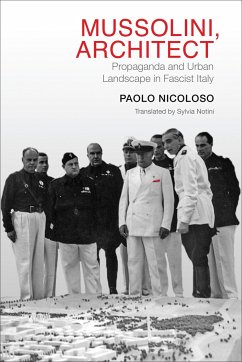Paolo NicolosoPropaganda and Urban Landscape in Fascist Italy
Mussolini, Architect
Propaganda and Urban Landscape in Fascist Italy
Übersetzer: Notini, Sylvia
Paolo NicolosoPropaganda and Urban Landscape in Fascist Italy
Mussolini, Architect
Propaganda and Urban Landscape in Fascist Italy
Übersetzer: Notini, Sylvia
- Gebundenes Buch
- Merkliste
- Auf die Merkliste
- Bewerten Bewerten
- Teilen
- Produkt teilen
- Produkterinnerung
- Produkterinnerung
Mussolini, Architect documents the numerous ways in which Mussolini used architecture to shape Italy and its citizens.
Andere Kunden interessierten sich auch für
![The Evidence Room The Evidence Room]() Anne BordeleauThe Evidence Room33,99 €
Anne BordeleauThe Evidence Room33,99 €![Hitler, Mussolini, and the Vatican Hitler, Mussolini, and the Vatican]() Emma FattoriniHitler, Mussolini, and the Vatican15,99 €
Emma FattoriniHitler, Mussolini, and the Vatican15,99 €![Maltzan - The Architect of Rapallo Maltzan - The Architect of Rapallo]() Pouyan ShekarlooMaltzan - The Architect of Rapallo42,95 €
Pouyan ShekarlooMaltzan - The Architect of Rapallo42,95 €![Donald Barthelme (Architect) Donald Barthelme (Architect)]() Donald Barthelme (Architect)26,99 €
Donald Barthelme (Architect)26,99 €![Making Yugoslavs Making Yugoslavs]() Christian Axboe NielsenMaking Yugoslavs92,99 €
Christian Axboe NielsenMaking Yugoslavs92,99 €![German Social Democracy Through British Eyes German Social Democracy Through British Eyes]() James RetallackGerman Social Democracy Through British Eyes100,99 €
James RetallackGerman Social Democracy Through British Eyes100,99 €![Galeazzo Ciano Galeazzo Ciano]() Tobias HofGaleazzo Ciano94,99 €
Tobias HofGaleazzo Ciano94,99 €-
-
-
Mussolini, Architect documents the numerous ways in which Mussolini used architecture to shape Italy and its citizens.
Hinweis: Dieser Artikel kann nur an eine deutsche Lieferadresse ausgeliefert werden.
Hinweis: Dieser Artikel kann nur an eine deutsche Lieferadresse ausgeliefert werden.
Produktdetails
- Produktdetails
- Verlag: University of Toronto Press
- Seitenzahl: 352
- Erscheinungstermin: 22. Juli 2022
- Englisch
- Abmessung: 228mm x 162mm x 35mm
- Gewicht: 669g
- ISBN-13: 9781442631045
- ISBN-10: 144263104X
- Artikelnr.: 62849399
- Herstellerkennzeichnung
- Libri GmbH
- Europaallee 1
- 36244 Bad Hersfeld
- gpsr@libri.de
- Verlag: University of Toronto Press
- Seitenzahl: 352
- Erscheinungstermin: 22. Juli 2022
- Englisch
- Abmessung: 228mm x 162mm x 35mm
- Gewicht: 669g
- ISBN-13: 9781442631045
- ISBN-10: 144263104X
- Artikelnr.: 62849399
- Herstellerkennzeichnung
- Libri GmbH
- Europaallee 1
- 36244 Bad Hersfeld
- gpsr@libri.de
Paolo Nicoloso is an associate professor of architectural history at the University of Trieste.
Acknowledgments
Abbreviations
Introduction
Chapter One: Travelling to See the Buildings
The Myth of the Duce as an Inaugurator
Building and Fighting
Buildings Built to "Endure"
In the City Where Fascism Was Born
Architects in the Dictator’s Entourage
Chapter Two: Mussolini’s Rome
The Third Rome
Demolishing "with No Holds Barred"
The Alert Eye
Visits to Building Sites in Rome
Architecture and the Legacy of Fascism
Rome, "Kingdom of the Unexpected"
Rome and Berlin: Parallel Action
The North-South Imperial Axis
Chapter Three: At Palazzo Venezia
The Success of the Exhibition of the Fascist Revolution
Restoring Augustus
Doubts about Terragni
The Rejection of Brasini’s Grandiose Architecture
Mussolini’s Oversights
Architecture for a Politics of Domination
Ponti’s Suggestions
"Rendering unto Caesar What Is Caesar’s"
Moretti instead of Piacentini?
Chapter Four: In the Architect’s Shoes
The Duce Approves
The Man with the Diktats
With Pencil in Hand
Advising the Architects
Zigzagging Forward
"I’m an Expert on Architecture"
Chapter Five: Piacentini and Mussolini
The Architect of the Littorian Order
A Special Rapport
Committed to the Party
Side by Side
In Praise of Organizational Perseverance
Chapter Six: Architecture Towards a Style
In Rome’s Città Universitaria
"Life Today" Requires a "Unity of Direction" in Architecture, Too
The E42 and the Matter of Style
The Swing Towards Classicism
At the E42 "History is Built"
Terragni’s Challenge, Pagano’s Silence, Bottai’s Dissent
Chapter Seven: The Totalitarian Acceleration and Architecture
Architecture for the Myths of the Totalitarian State
Piacentini’s Architectural Unity
For Imperial Rome
The 1941 "Variante" of Rome's Urban Development Plan
Hitler’s Plan for Imperial Berlin
For Imperial Milan
A National "Unity of Direction"
A Private Monopoly in a Totalitarian Regime
Conclusion
Index of Names and Subjects
Index of Places
Abbreviations
Introduction
Chapter One: Travelling to See the Buildings
The Myth of the Duce as an Inaugurator
Building and Fighting
Buildings Built to "Endure"
In the City Where Fascism Was Born
Architects in the Dictator’s Entourage
Chapter Two: Mussolini’s Rome
The Third Rome
Demolishing "with No Holds Barred"
The Alert Eye
Visits to Building Sites in Rome
Architecture and the Legacy of Fascism
Rome, "Kingdom of the Unexpected"
Rome and Berlin: Parallel Action
The North-South Imperial Axis
Chapter Three: At Palazzo Venezia
The Success of the Exhibition of the Fascist Revolution
Restoring Augustus
Doubts about Terragni
The Rejection of Brasini’s Grandiose Architecture
Mussolini’s Oversights
Architecture for a Politics of Domination
Ponti’s Suggestions
"Rendering unto Caesar What Is Caesar’s"
Moretti instead of Piacentini?
Chapter Four: In the Architect’s Shoes
The Duce Approves
The Man with the Diktats
With Pencil in Hand
Advising the Architects
Zigzagging Forward
"I’m an Expert on Architecture"
Chapter Five: Piacentini and Mussolini
The Architect of the Littorian Order
A Special Rapport
Committed to the Party
Side by Side
In Praise of Organizational Perseverance
Chapter Six: Architecture Towards a Style
In Rome’s Città Universitaria
"Life Today" Requires a "Unity of Direction" in Architecture, Too
The E42 and the Matter of Style
The Swing Towards Classicism
At the E42 "History is Built"
Terragni’s Challenge, Pagano’s Silence, Bottai’s Dissent
Chapter Seven: The Totalitarian Acceleration and Architecture
Architecture for the Myths of the Totalitarian State
Piacentini’s Architectural Unity
For Imperial Rome
The 1941 "Variante" of Rome's Urban Development Plan
Hitler’s Plan for Imperial Berlin
For Imperial Milan
A National "Unity of Direction"
A Private Monopoly in a Totalitarian Regime
Conclusion
Index of Names and Subjects
Index of Places
Acknowledgments
Abbreviations
Introduction
Chapter One: Travelling to See the Buildings
The Myth of the Duce as an Inaugurator
Building and Fighting
Buildings Built to "Endure"
In the City Where Fascism Was Born
Architects in the Dictator’s Entourage
Chapter Two: Mussolini’s Rome
The Third Rome
Demolishing "with No Holds Barred"
The Alert Eye
Visits to Building Sites in Rome
Architecture and the Legacy of Fascism
Rome, "Kingdom of the Unexpected"
Rome and Berlin: Parallel Action
The North-South Imperial Axis
Chapter Three: At Palazzo Venezia
The Success of the Exhibition of the Fascist Revolution
Restoring Augustus
Doubts about Terragni
The Rejection of Brasini’s Grandiose Architecture
Mussolini’s Oversights
Architecture for a Politics of Domination
Ponti’s Suggestions
"Rendering unto Caesar What Is Caesar’s"
Moretti instead of Piacentini?
Chapter Four: In the Architect’s Shoes
The Duce Approves
The Man with the Diktats
With Pencil in Hand
Advising the Architects
Zigzagging Forward
"I’m an Expert on Architecture"
Chapter Five: Piacentini and Mussolini
The Architect of the Littorian Order
A Special Rapport
Committed to the Party
Side by Side
In Praise of Organizational Perseverance
Chapter Six: Architecture Towards a Style
In Rome’s Città Universitaria
"Life Today" Requires a "Unity of Direction" in Architecture, Too
The E42 and the Matter of Style
The Swing Towards Classicism
At the E42 "History is Built"
Terragni’s Challenge, Pagano’s Silence, Bottai’s Dissent
Chapter Seven: The Totalitarian Acceleration and Architecture
Architecture for the Myths of the Totalitarian State
Piacentini’s Architectural Unity
For Imperial Rome
The 1941 "Variante" of Rome's Urban Development Plan
Hitler’s Plan for Imperial Berlin
For Imperial Milan
A National "Unity of Direction"
A Private Monopoly in a Totalitarian Regime
Conclusion
Index of Names and Subjects
Index of Places
Abbreviations
Introduction
Chapter One: Travelling to See the Buildings
The Myth of the Duce as an Inaugurator
Building and Fighting
Buildings Built to "Endure"
In the City Where Fascism Was Born
Architects in the Dictator’s Entourage
Chapter Two: Mussolini’s Rome
The Third Rome
Demolishing "with No Holds Barred"
The Alert Eye
Visits to Building Sites in Rome
Architecture and the Legacy of Fascism
Rome, "Kingdom of the Unexpected"
Rome and Berlin: Parallel Action
The North-South Imperial Axis
Chapter Three: At Palazzo Venezia
The Success of the Exhibition of the Fascist Revolution
Restoring Augustus
Doubts about Terragni
The Rejection of Brasini’s Grandiose Architecture
Mussolini’s Oversights
Architecture for a Politics of Domination
Ponti’s Suggestions
"Rendering unto Caesar What Is Caesar’s"
Moretti instead of Piacentini?
Chapter Four: In the Architect’s Shoes
The Duce Approves
The Man with the Diktats
With Pencil in Hand
Advising the Architects
Zigzagging Forward
"I’m an Expert on Architecture"
Chapter Five: Piacentini and Mussolini
The Architect of the Littorian Order
A Special Rapport
Committed to the Party
Side by Side
In Praise of Organizational Perseverance
Chapter Six: Architecture Towards a Style
In Rome’s Città Universitaria
"Life Today" Requires a "Unity of Direction" in Architecture, Too
The E42 and the Matter of Style
The Swing Towards Classicism
At the E42 "History is Built"
Terragni’s Challenge, Pagano’s Silence, Bottai’s Dissent
Chapter Seven: The Totalitarian Acceleration and Architecture
Architecture for the Myths of the Totalitarian State
Piacentini’s Architectural Unity
For Imperial Rome
The 1941 "Variante" of Rome's Urban Development Plan
Hitler’s Plan for Imperial Berlin
For Imperial Milan
A National "Unity of Direction"
A Private Monopoly in a Totalitarian Regime
Conclusion
Index of Names and Subjects
Index of Places








